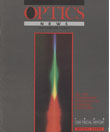
August, 1989 Issue
Feature Articles
Self- and coupled-phase modulations of ultrashort laser pulses
The use of light to control and to generate light is most important in the fields of lasers and optical communication. One dramatic and still useful nonlinear optical phenomenon observed by Alfano and Shapiro over 19 years ago arising from self-phase-modulation (SPM) is the supercontinuum. Self-Induced and Cross phase modulation processes are responsible for the generation of the spectral broadened supercontinuum ultrashort laser pulses. The super-continuum spans over 10,000 cm-1 from the UV to IR with picosecond to femtosecond duration. A femtosecond supercontinuum spectrum generated by passing a 120-fs 625-nm laser pulse through a 1-mm long carbontetrachloride liquid and dispersed with a grating (Fig. 1) is displayed on the front cover. In this report, we highlight the result and development of the current status of supercontinuum generation.
by R.R. Alfano and P.P. HoMeasurement standards span all fields
This month's column was prompted by a letter from a professor in Portugal to the International Commission for Optics (ICO), asking about generally accepted terms and definitions in optics. By a circuitous route, the letter ended up on my desk and prompted a look at an International Standards Organization (ISO) publication called the ISO Standards Handbook 2, Units of Measurement.
by Robert E. ParksComplexities and progress in studies of optical chaos
Deterministic chaos has come to public appreciation (via a recent PBS special and James Gleick's book Chaos) and to the quantum electronics community (via a new understanding of the pervasive irregularity of laser pulsations)1 at about the same present moment. The broader ubiquity of chaos and the intellectual challenges of its study are demonstrated by the interest of artists, astronomers, chemists, economists, mathematicians, neuroscientists, and physicists.
by Neal B. Abraham

![A multiplexed image of a human tonsil acquired. [NIAID] using the iterative bleaching extends multiplexity (IBEX) method.](https://opnmedia.blob.core.windows.net/$web/opn/media/images/articles/2024/0424/departments/202404-cover-web.jpg?ext=.jpg)
